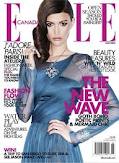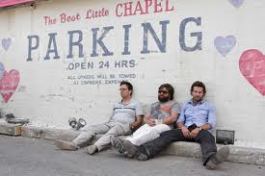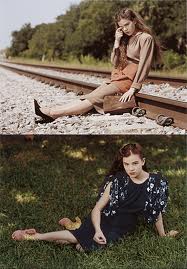The other day I was being amused by my dog, Oscar, who has taught himself to maneuver his ball around with his nose while simultaneously chasing after it, a skill that provides him with hours of entertainment and exercise and requires no effort on my part. A young girl approached whom I didn’t recognize, along with a friend. She called Oscar by name, explaining that her mother had dogsitted for us before. On second glance I did recognize her as the 12 year-old daughter of our regular sitter, however the last and only time I had seen her she had been about to go to bed, fresh and clean and wearing a long cotton night dress that would have been perfect for a purity pledge sleepover. The girl before me looked like she had walked out of a poorly styled rap video. Her shorts, while already short enough to make me question if there was a manufacturer defect, were rolled up one more time to ensure there was no question of the fact she was indeed wearing underpants. Her shirt was slightly cropped although not as much so as her friend’s which may actually have been an undergarment. Both girls had dyed the tips of their hair purple, a fad among young Hollywood celebrities these days (I’m hip to the trends). After both girls had said their hellos to Oscar, they went back to their I-phone 4Gs and resumed what I assumed to be texting their friends while I continued to stare at them with a mixture of shock, disbelief, sadness and fear.
Pinpointing why seeing these young girls in clothing that would be only questionably appropriate on even an adult woman bothered me so much was difficult. Of course I thought these girls were much too young to be dressing so provocatively. However, I kept thinking that although these outfits were unquestionable “sexy” in nature, no one in their right mind could look at these 12 year-old girls and have a sexual thought about them. It seemed apparent that neither of them had gone through puberty yet. Although both had bra straps visible, there was no evidence that such underwear was for anything but show as both girls still had the reed-like figures of children, lacking any curves which would distinguish then from their male counterparts save their long hair and 5 pounds of make-up. These girls are simply not sexual beings yet. But deep down I fear that they could be and that they will be. These girls represent thousands and millions of other young, vulnerable 12 year-old girls today who are subject to exposures and pressures that their parents and older siblings couldn’t even imagine. Are these girls covering themselves less in response to current trends, or are they finding themselves in an increasingly hyper-sexualized environment and setting out to appear desirable in the way that they have been taught by society to do so (by wearing little clothing)? Or both?
It seems as though girls are becoming aware of the concept of sexuality at a very young age. A study performed by Jennifer Abbasi and published online July 6th in Sex Roles showed that girls as young as 6 were beginning to think of themselves as sex objects. In the study, 60 girls 6-9 years old were each shown two dolls, one wearing “sexy” clothes and the other a trendy but conservative outfit. The girls were then asked to choose the doll that looked like herself, looked how she wanted to look, was the popular girl in school, and who she wanted to play with. In all categories the girls chose the “sexy” doll, with 68% wanting to look like her and 72% saying she was the more popular.
Where would a six year old get this perception? Well if you are watching Toddlers and Tiaras with her, or worse if she is ON Toddlers and Tiaras, look no further for your answer. Otherwise she is likely sensitive to the same media images that all women, teens and tweens are bombarded with day after day. The images that tell us what sexy is and how we can achieve it. I can think of no other reason I turn over to allow a perfect stranger to pour hot wax on my most private part during a Brazilian wax I derive no pleasure from. In the article ‘Teenage Girls Report Pressure To Live up to Sexual Ideals’ by Alexandra Topping published on July 14 2008 in The Guardian UK results from a study by Girlguiding UK and the Mental Health Foundation were published. The study showed that two in five teen girls felt worse about themselves after looking at pictures of models, pop stars and actresses in magazines. Furthermore “the girls questioned described being put under sexual pressure from boys at school or feeling obliged to wear clothes that made them look older.” Many of the girls felt bad about how they looked and their weight. Of the 10-14 year-old, 32% had a friend who had an eating disorder, 42% knew someone who had harmed themselves, and half knew someone who had suffered from depression.
These numbers are similar to those reported in a May 2010 article on Macleans.ca by Kate Fillion titled “Inside the Dangerously Empty Lives of Teenage Girls where she interviews Dr. Leonard Sax, author of Girls on the Edge, about today’s teen and tween girls. He has also written two books about the gender differences between girls and boys. He reports that 1 in 5 girls in the US is cutting or burning herself. 1 in 4 high-school girls is binge drinking. I in 8 takes antidepressants.
Social media is also playing a big part in the image young girls are able to present of themselves to their peers and the general public in cyberspace. Girls become fixated on presenting the perfect image of themselves on social media sites, and can lose sight of who they are and who they really want to be. They don’t derive any real value or positive reinforcement of themselves as a human being through this type of networking as any type of interaction is strictly superficial. According to Dr. Sax “Girls spend a lot of time photoshopping their pictures, making themselves look a little bit thinner than they are and getting rid of the pimples, because they know boys are interested in the photos on these sites. So you’ve got 14-year-old girls essentially presenting themselves as a brand, trying to create a public persona, polishing an image of themselves that’s all surface: how you look and what you did yesterday, not who you are and what you want to be. And that leads to a sense of disconnection from themselves, because in most cases, these girls don’t even realize that their persona is not who they are. They’re just focused on striving to please their market and presenting the brand they think will sell.” And unfortunately as we all know, sex sells.
When I was 12, I was in 7th grade. I wore Guess jeans and corduroy pants to school. I wore turtlenecks and teased my bangs into this ridiculous style I now call “the rainbow”. It wasn’t pretty. My mother bought all of my clothes, and while I once cried until she broke down and bought me a pair of white Sorel boots I absolutely NEEDED or I would DIE, it would have been a cold day in hell before she ever bought me bootie shorts, a crop top or thong underwear in junior high. Or now come to think of it. Furthermore, many of these young girls look too small to be shopping in the adult section. However, according to Jean Twenge from San Diego University in the same Macleans article “Forty years ago, if you went into a department store and looked at clothes for seven-year-olds, they’d be quite different than the clothes on sale for 17-year-olds. Today there’s no longer any distinction; the same short skirts are sold to girls in Grade 2 and girls in Grade 12. T-shirts that say, “Yes, but not with you” are now sold to eight-year-olds. Girls understand what these T-shirts are about: pretending to be sexually aware.” Furthermore, because such clothing is sold in children’s clothing stores and in children’s sizes, parents are less resistant to buying it for their daughters. They think it is normal and appropriate. Suddenly this is popular culture. On slate.com Emily Yoffe wrote about back-to-school clothes shopping with her daughter in a piece called Lolita’s Closet. “A few years ago, Abercrombie, the ‘tween division of Abercrombie & Fitch, got in trouble for marketing thong underpants—with phrases such as “eye candy” printed on them—to prepubescent girls. Now scanty panties for girls are standard. At Limited Too there were pairs with rhinestone hearts or printed with cheeky sayings such as “Buy It Now! Tell Dad Later!” My dad was upset when my mother let me get my ears pierced at 12. He thought he caught a boy looking at me, as if mesmerized by the shining 10 karat gold-plated gems in my awkward tween ears and not just a horny hormone-filled adolescent pimple canvas. Thong panties? I would not have wanted to be around for that conversation.
The more overtly style of dress young girls seem to have adopted is not surprising in our culture today. But are today’s youth being more sexual than those of prior decades? The answer is yes and no. Jean Twenge says “kids may be sexually intimate—the term as I use it includes both oral sex and intercourse—a little earlier and certainly they are much more likely to be having oral sex than they were 20 years ago. There are some troubling new issues. You find a lot of 12- and 13-year-old girls who are providing sexual favours to 16- and 17-year-old boys.” According to the July 2008 Tween and Teen Dating Violence and Abuse Study 47% of tweens (11-14 year-olds) and 37% of 11 and 12 year-olds say they been in a boyfriend/girlfriend relationship. 37% of tweens say touching and “feeling up” is part of tween dating relationships. 27% say so is oral sex. 28% say sex is a part of tween relationships. 31% of tweens know a friend or peer who have had oral sex and 33% know one who has had sexual intercourse. Another difference according to an April 2009 article in Macleans magazine “Teen Girls in Charge” is that “nearly half of female adolescents now say it’s acceptable to have sex after a few times out together, up from 35 per cent in 1984. “Making out” is okay after being with someone a few times has rocketed up from 79 to 94 per cent, which almost puts them on par with the guys, who are at 96 per cent.” Teen girls appear to be becoming more sexually aggressive, taking charge of their sexuality.
These numbers seem high, and it does appear that tweens are experimenting with sexual activity such as oral sex earlier. But one positive is that overall the numbers of teens who are sexually active is not increasing. In fact, according to Statistics Canada, the percentage of youth virgins is increasing, as is condom use, and as a result teen pregnancy is decreasing. In the US 2011 and 2008 data are very similar showing that there also does not seem to be an increase in the number of teenagers having sex. There is also good evidence that parents and role models can play a big role in their children’s sexual health. The National Survey of Family Growth conducted from 2006 to 2008 by the Guttmacher Institute and reported by Stephanie Pappas on March 8 2012 on Livescience.com (Sex Education Delays Teen Sex) showed that teens young men and women 15-24 who received any sort of sex education were more likely to delay sex, and use contraception during their first sexual encounter. Another study in the June 15 2011 issue of the Montreal Gazette by Laura Baziuk reported that 45% of teens look to their parents as their sexual role models. (Over their friends, celebrities, or no one at all). So with girls being sexually aware at a younger age parents should prepare themselves to talk to their daughters about sex earlier than ever. And read up before you do. She probably already knows a lot more than you think.

























